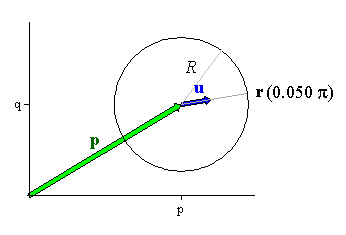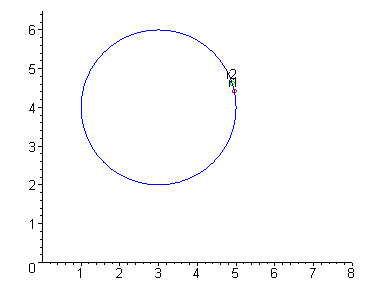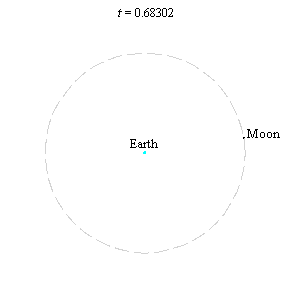Part 3: Parameterizations of Circles
In example 2, we showed that the unit circle
has a parameterization of
|
u(q) =
á cos(q), sin(q)
ñ |
| |
where q is in radians.
Consequently, if a circle of radius R centered at a point (p,q) has a
counterclockwise orientation,

|
|
click to toggle animation |
|
then its standard parameterization is given by
where p = (p,q) is the position vector of the center. Straightforward vector
arithmetic subsequently yields
|
r(q) =
á p + R cos( q), q + R sin( q)
ñ |
| (2) |
where q is in radians.
EXAMPLE 6 What is the standard parametrization of a circle
with radius 1 centered at ( 0,1) ?
Solution: Substituting p = 0, q = 1, and R = 1 into (2) yields
|
r(q) =
á cos(q),1+sin( q)
ñ |
|
To verify this, notice that x = cos( q) and y = 1+sin( q) implies that
|
x2 + ( y - 1)2 = cos2( q) + sin2(q) = 1 |
|
An object is said to be in uniform circular motion if it is moving in a circle
with a parameterization (2) in which
where the constant w is the angular speed in radians per second and t0 is the
time at which
q vanishes (i.e., is equal to 0). That is, the parameterization of
the position of an object in uniform circular motion is given by
|
r( t) =
á p + R cos( w(t - t0) ), q + R sin( w(t - t0) )
ñ |
|
Alternatively, uniform circular motion shows us that a curve (such as a circle)
has infinitely many parameterizations. Examples 5 and 6 are also illustrations
of this fact.
EXAMPLE 7 Two
objects are moving on a circle with radius 2 centered at (3,4) with angular
speeds of 2 radians per second and 3 radians per second, respectively.
Parameterize the motion of each object and compare the two given that both
are at q = 0 initially.
Solution: To begin with, q = 0 initially means that t0 = 0. Thus, if we denote the two motions by r1(t) and r2( t) , respectively, then
|
r1(t) = á 3 + 2cos(2t), 4 + 2sin(2t)
ñ |
|
|
r2(t) = á 3 + 2cos(3t), 4 + 2sin(3t)
ñ |
|
|
Moreover the second object will traverse the circle 3 times for every 2
traversals of the circle by the first object. Indeed, r1(t) and r2(t)
are shown below for ever increasing values of t.
 |
|
click to toggle animation |
|
The fundamental period of a uniform circular motion r(t) is the smallest
positive number T for which
|
r( t + T) = r(t) for all t
|
| (3) |
That is, T is the time it takes an object in uniform circular motion to make one
complete cycle around the circle. Since q = 2p radians is the angle corresponding to one complete cycle, it follows
that
Thus, if we are given the period of a uniform circular motion, we can use
(3) to calculate its angular speed.
EXAMPLE 8 The
moon's orbit is nearly a uniform circular motion with a radius of 238,957
miles and a period of 27.321 days. What is the parameterization of the
moon's orbit about the earth?
Solution: Assuming the earth is centered at (0,0), the
angular speed--in radians per day-- of the moon about the earth is
To 4 decimal places, this is w=0.23, so that a parameterization of the
moon's orbit about the earth is
|
r( t) =
á 238957 cos( 0.23 t), 238957sin( 0.23 t)
ñ |
|
where r(t) is in miles and t is in days.
 |
|
click to toggle animation |
|
Check your Reading: Explain why the moon's motion can also be parameterized
by
